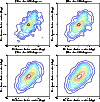 |
Figure 1: 2dF redshift histogram for the A3667 field; the inset plot shows an enlarged version of the cluster redshift distribution. |
| Open with DEXTER | |
In the text
 |
Figure 2: Distribution on the sky of galaxies with measured redshifts in the region of A3667. Filled circles are the 2dF data and open circles are the redshifts from the literature. Where the 2dF and literature datasets agree in both position and redshift, the circle is shown filled and outlined. The arcs denote the outside edges of the radio relics. |
| Open with DEXTER | |
In the text
 |
Figure 3: Redshift comparison for A3667. The literature redshift is plotted against the 2dF redshift for the 67 sources in common. Clustering about the slope of unity suggests there is no overall systematic difference between the two datasets. The four labelled outliers are discussed in the text; the number corresponds to its identification number in the online version of Table 2. |
| Open with DEXTER | |
In the text
 |
Figure 4:
Coverage of galaxies for which spectroscopic redshifts have been
determined. Filled gray circles are all the galaxies down to
|
| Open with DEXTER | |
In the text
 |
Figure 5: Redshift distribution for A3667 with a Gaussian fitted to the central peak. The Gaussian is centred at the mean redshift of z=0.0555 and there is a weak excess at around 0.0625. The velocity dispersion is 1102 km s-1. |
| Open with DEXTER | |
In the text
 |
Figure 6: Redshift distribution for the combined dataset of 231 galaxies as a function of RA and Dec, measured in degrees from the cluster centre. |
| Open with DEXTER | |
In the text
 |
Figure 7:
Galaxy isodensity plots for A3667, generated by application
of Gaussian filters of various sizes (from
|
| Open with DEXTER | |
In the text
 |
Figure 8: Galaxy type spatial distribution for the 143 galaxies in the 2dF dataset. |
| Open with DEXTER | |
In the text